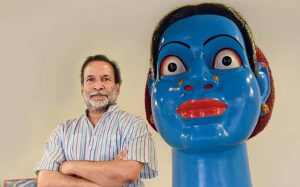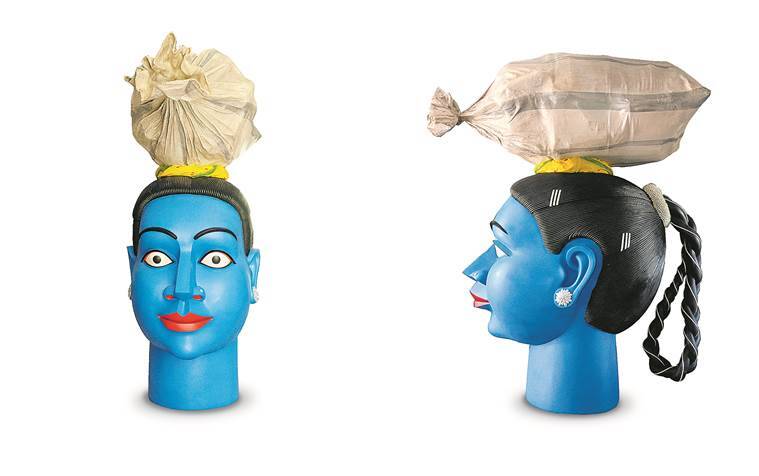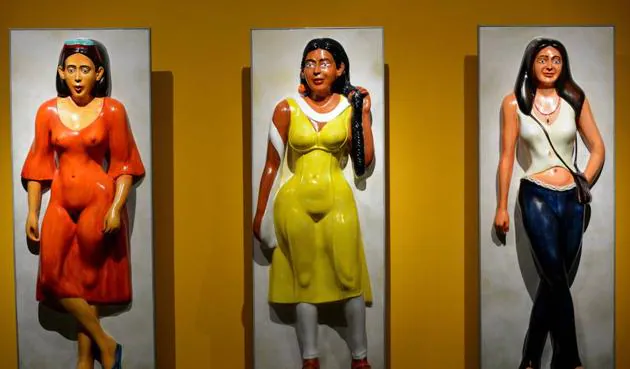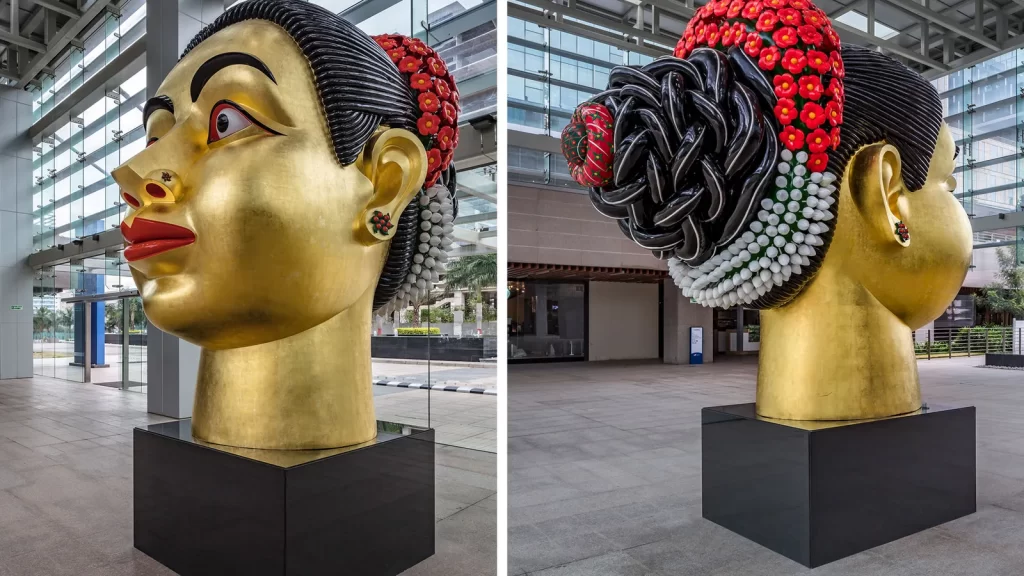Abhishek Kumar
G Ravinder Reddy is an Indian sculptor and installation artist known for his large-scale figurative sculptures. His works are characterized by a unique combination of traditional Indian craftsmanship, modern techniques, and vivid use of colour. He often incorporates elements of traditional Indian costume, jewellery, and ornamentation into his sculptures, creating works that are both visually arresting and conceptually complex. Reddy’s works often focus on the female form, drawing inspiration from traditional Indian gods and goddesses as well as from every day women of India. By exploring the interplay between traditional values and modern sensibilities, Reddy’s art speaks to the changing roles of women in India and the larger context of globalization.

Ravinder Reddy is a contemporary Indian artist who was born in Andhra Pradesh in 1956. He is known for his distinctive style of blending elements of pop art with traditional Hindu sculptural traditions, creating works that are both playful and thought-provoking. Reddy received his artistic education in India and went on to pursue further studies in the United Kingdom. Throughout his career, he has been recognized as a major figure in Indian contemporary art and his works have been widely exhibited both in India and around the world.
Reddy’s approach to art is highly stylized and graphic, and he often uses bright colors and bold forms to create works that are eye-catching and impactful. Through this style, he invites viewers to reconsider the role of religion and tradition in contemporary society and to question their own perceptions of what is sacred and what is secular. In addition to his innovative style, Reddy is also known for his technical prowess as a sculptor. He often uses materials such as fiberglass and resin to create works that are both lightweight and durable, and he is known for his mastery of techniques such as casting and mold-making.
Reddy’s choice to work with larger-than-life figures is driven by his desire to evoke a sense of reverence and awe, to create visually impactful works, and to explore the interplay of form and colour in his art. Through this approach, he creates a unique and powerful visual style that speaks to the enduring importance of Hindu tradition and the complexities of contemporary Indian culture.
Reddy has always centered her work on women. Whether depicted as enormous heads or figurative, sensual sculptures, his entire body of work is a celebration of the female form, captured by his attention to detail as well as his admiration for the feminine. A set of three life-size figures with the title ‘Relief’ is one such piece that exemplifies the latter mode of expression. These three lifelike, fully-clothed figures, created in 1981, show the intimate aspects of the female body in a way that is both startling and unflinching. There is a vast yet contained sensuality in all of his images, whether it is the nudists or characters inspired by events from daily life, like in ‘Girl with Umbrella’, where he draws inspiration from stenographers travelling to work in Mumbai in the early 1980s.
“The women fall short from showcasing themselves as an object of desire; their disembodied eyes – alternately all possessing and unseeing – transform them into formidable apparitions or comic spectacle, which shifts between mocking parody and iconic grandeur,” writes Art scholar R Siva Kumar on Reddy.
Ravinder Reddy often chooses to work with larger-than-life figures and faces in his art as a means of emphasizing the grand, imposing quality of Hindu deities. By enlarging these figures, he imbues them with a sense of power and presence, making them more imposing and awe-inspiring to the viewer. In Hindu tradition, many deities are depicted as larger-than-life figures in order to convey their cosmic significance and to evoke a sense of reverence and awe. By working in this tradition, Reddy underscores the central role that Hindu deities play in Indian culture and invites viewers to consider their timeless importance.

Reddy’s works often feature larger-than-life figures and faces that are inspired by Hindu deities such as Ganesha and Kali. He reimagines these figures in a bold, colourful style that incorporates elements of popular culture, creating a unique and innovative visual style that speaks to the changing cultural landscape of modern India. Through his works, Reddy invites viewers to reconsider the role of religion and tradition in contemporary society and to question their own perceptions of what is sacred and what is secular. His art is both a celebration of Hindu tradition and a critique of modern consumer culture, and it continues to inspire and challenge audiences around the world.
Additionally, working with larger-than-life figures allows Reddy to create works that are highly visible and impactful. By creating works that are larger than life, he creates an immediate visual impact that draws the viewer’s attention and engages them with the subject matter. Finally, working with large figures also allows Reddy to explore the interplay of form and colour in his art in a more dynamic and impactful way. The larger scale of his works provides ample space for him to play with colour, texture, and form, creating highly stylized and graphic images that are both beautiful and thought-provoking.

Reddy’s use of bright colours and bold eye-catching forms is inspired by the bright, graphic quality of pop art, which emerged in the 1950s and 1960s as a reaction to the blandness and mass-produced nature of modern culture. At the same time, his work is rooted in Hindu sculptural traditions, which often feature intricate, highly stylized forms and rich, symbolic meaning. Through this fusion of contemporary pop art and Hindu sculptural tradition, Reddy aims to create a new visual language that speaks to the changing cultural landscape of modern India. By reimagining Hindu deities in a bold, pop art style, he invites viewers to reconsider the role of religion and tradition in contemporary society and to question their own perceptions of what is sacred and what is secular.
Reddy’s work is not only a visual celebration of Hindu traditions, but also a critique of modern consumer culture. By taking the forms and symbols of Hindu deities and presenting them in a bright, consumer-friendly style, he highlights the commercialization and commodification of religious iconography in contemporary society. In this sense, Reddy’s work is both playful and thought-provoking, inviting viewers to consider the deeper cultural and philosophical implications of the images they are seeing. At the same time, it is a testament to the enduring power of Hindu tradition, which continues to influence and shape modern Indian culture in profound ways.
Reddy’s work has been widely celebrated and has been the subject of numerous exhibitions and retrospectives in India and around the world. It has been recognized as a major contribution to the field of contemporary art and has been widely recognized as a key example of the fusion of tradition and modernity in contemporary Indian culture. New York Times Art Critic Holland Cotter said in a review of Reddy’s first solo show in New York, “The spirelike roofs of certain Hindu temples in South India are a dizzying pileup of hundreds of brightly painted carved figures. Most are of deities, but the ever-changing mix can also include politicians, movie idols and even an occasional Westerner of local renown. This blending of religion and pop culture is a constant in Indian art, and it is the impetus behind the work of Ravinder G. Reddy. [His] painted and gilded fiberglass sculptures of women have been among the most visible examples of contemporary South Asian art since they first made a splash in ‘Traditions/Tensions’ at the Asia Society in 1996.”

Ravinder Reddy’s idea of fusing contemporary pop art and Hindu sculptural tradition is a powerful and innovative approach to creating art that speaks to the complexities and contradictions of contemporary Indian culture. By combining elements of ancient tradition with the bright, bold forms of modern pop art, he creates a unique and thought-provoking visual style that invites viewers to consider the role of religion, tradition, and culture in the modern world.





